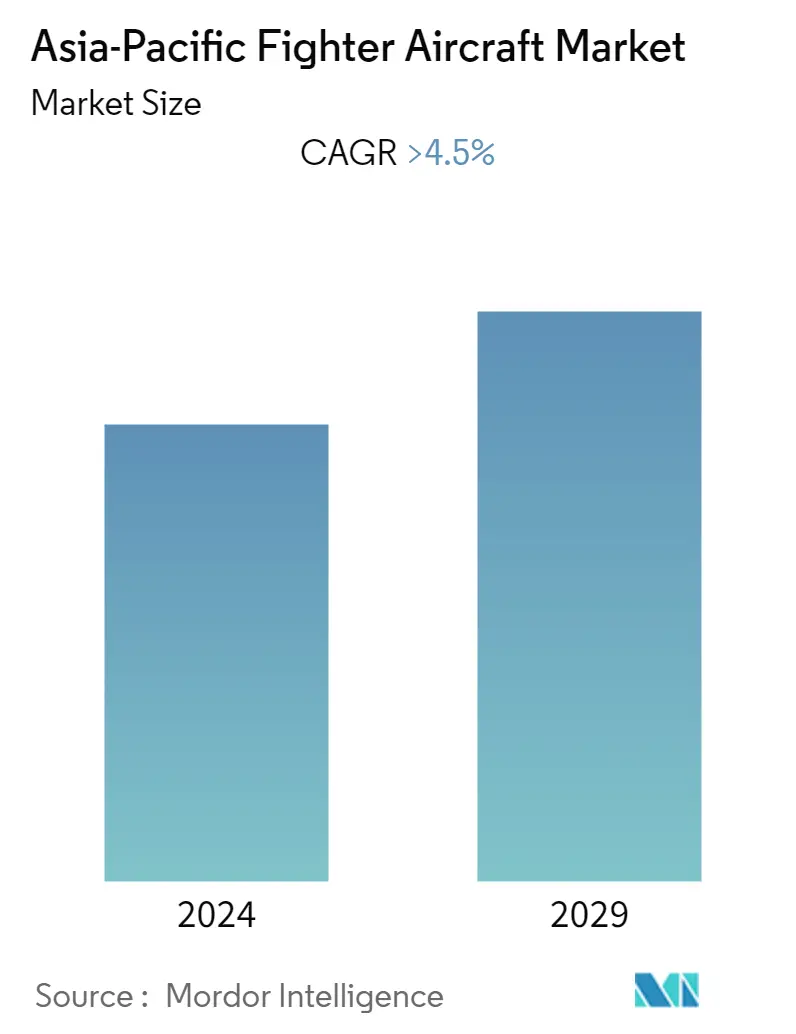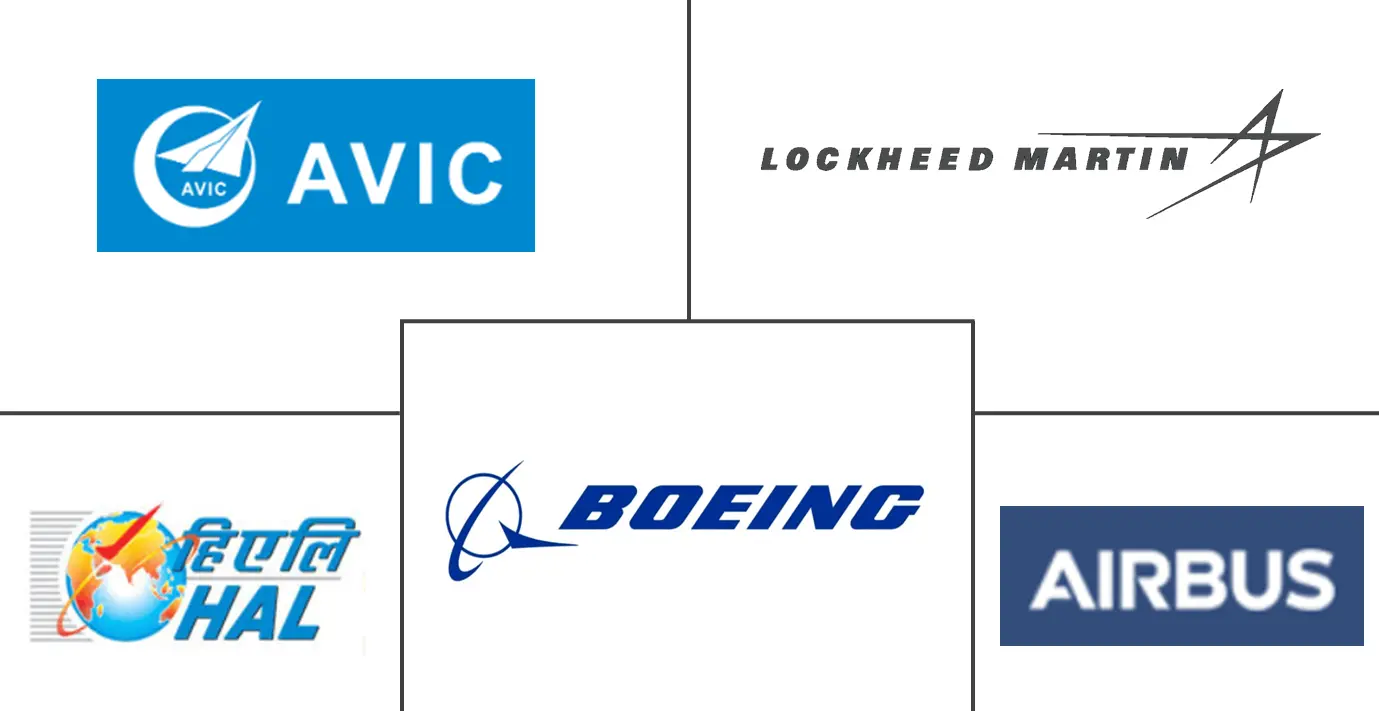Market Size of Asia-Pacific Fighter Aircraft Industry

| Study Period | 2019 - 2029 |
| Base Year For Estimation | 2023 |
| Forecast Data Period | 2024 - 2029 |
| Historical Data Period | 2019 - 2022 |
| CAGR | 4.50 % |
Major Players
*Disclaimer: Major Players sorted in no particular order |
Asia-Pacific Fighter Aircraft Market Analysis
The Asia-Pacific Fighter Aircraft Market is anticipated to register a CAGR of over 4.5% during the forecast period.
- The geopolitical tensions and territorial disputes among the neighboring countries have led to the growth of defense spending in the Asia-Pacific region. The increasing military spending is anticipated to drive the fighter aircraft market in the region.
- The countries' military modernization plans to replace their aging fighter aircraft with newer generation aircraft are propelling the demand for fighter aircraft in the region.
- Various government initiatives were taken to support the indigenous manufacturing of combat aircraft in countries like China, India, and Japan, which bolstered the growth of local manufacturing of aircraft.
Asia-Pacific Fighter Aircraft Industry Segmentation
A fighter aircraft can be termed as a high-speed military aircraft, which can carry out air-to-air combat missions. High speed, ease in maneuvering, and relatively smaller size are considered the fighter aircraft's hallmarks. These aircraft can also carry heavy payloads and perform electronic warfare, ground attacks, and air-to-air combat. The report also covers the increasing adoption of fighter aircraft in the Asia-Pacific region. It analyzes the conventional take-off and landing, short take-off and landing, and vertical take-off and landing segments.
| Take-off and Landing | |
| Conventional Take-off and Landing | |
| Short Take-off and Landing | |
| Vertical Take-off and Landing |
| Geography | ||||||||
|
Asia-Pacific Fighter Aircraft Market Size Summary
The Asia-Pacific Fighter Aircraft Market is poised for significant growth, driven by increasing defense expenditures and military modernization efforts across the region. Geopolitical tensions and territorial disputes have prompted countries to enhance their military capabilities, leading to a surge in demand for fighter aircraft. This demand is further fueled by initiatives to support indigenous manufacturing in nations such as China, India, and Japan, which have bolstered local production capabilities. The market is characterized by a strong focus on replacing aging aircraft with newer generation models, with conventional take-off and landing aircraft currently holding the largest market share. The development of advanced aircraft models, such as India's HAL's fifth-generation stealth fighter under the AMCA program, is expected to further propel market growth.
China's military modernization is a key driver in the region, with substantial investments in advanced technologies to strengthen its armed forces. The country's defense budget has seen significant increases, aimed at enhancing air, land, and sea capabilities amid rising tensions with the US and neighboring countries. The development and procurement of new aircraft, including the J-20 stealth fighter, are central to China's strategy to replace older models and maintain air superiority. Prominent players in the market include Boeing, Airbus, AVIC, Lockheed Martin, and Hindustan Aeronautics Limited, with government support for indigenous manufacturing playing a crucial role. The introduction of new aircraft models and technological upgrades are expected to support the long-term growth strategies of these companies in the Asia-Pacific region.
Asia-Pacific Fighter Aircraft Market Size - Table of Contents
-
1. MARKET DYNAMICS
-
1.1 Market Overview
-
1.2 Market Drivers
-
1.3 Market Restraints
-
1.4 Porter's Five Forces Analysis
-
1.4.1 Threat of New Entrants
-
1.4.2 Bargaining Power of Buyers/Consumers
-
1.4.3 Bargaining Power of Suppliers
-
1.4.4 Threat of Substitute Products
-
1.4.5 Intensity of Competitive Rivalry
-
-
-
2. MARKET SEGMENTATION
-
2.1 Take-off and Landing
-
2.1.1 Conventional Take-off and Landing
-
2.1.2 Short Take-off and Landing
-
2.1.3 Vertical Take-off and Landing
-
-
2.2 Geography
-
2.2.1 Asia-Pacific
-
2.2.1.1 India
-
2.2.1.2 China
-
2.2.1.3 Japan
-
2.2.1.4 Australia
-
2.2.1.5 South Korea
-
2.2.1.6 Rest of Asia-Pacific
-
-
-
Asia-Pacific Fighter Aircraft Market Size FAQs
What is the current Asia-Pacific Fighter Aircraft Market size?
The Asia-Pacific Fighter Aircraft Market is projected to register a CAGR of greater than 4.5% during the forecast period (2024-2029)
Who are the key players in Asia-Pacific Fighter Aircraft Market?
The Boeing Company, Lockheed Martin Corporation, Airbus SE, Aviation Industry Corporation of China (AVIC) and Hindustan Aeronautics Limited are the major companies operating in the Asia-Pacific Fighter Aircraft Market.

